What is a Business Model?
Communication and Self-Reflexion tool
The Business Model concept has become common place in many industries and is proving valuable as both a communication and self-reflexion tool. It has also spread to strategic practices as a means of in depth checking of a strategic design.
The stakes are as much in the coherence, consistency of the strategic vision and enterprise architecture as in the ability to mobilize and convince the various stakeholders and materialize the vision.
This becomes even more crucial in a context where „economic instability became the rule and therefore requires the company to demonstrate constant agility in order to adapt and even create innovative solutions to ensure its development” ( [Vilain11] ) .
As stressed by Grandval and Ronteau, the BM concept can be leveraged by strategists, to regain the freedom to formulate a strategic intention and guide the strategic action (in the original and military sense of the word strategy ). It can as well assist the management team in identifying and organizing the company efficiently and effectively through continuous business innovation. Rethinking and improving a company’s strategy often starts with establishing a genuine model of its current businesses.

Furthermore, a Business Model can be viewed as a didactic description of the strategic vision and its implementation. It help managers and entrepreneurs build narrative or stories in a coherent manner and allows for effective communication with the company’s stakeholders (customers, employees, partners, suppliers, investors). It is a valuable tool to get the different stakeholders involved and supportive
A Business model answer Peter Drucker’s questions
As underpinned by Joan Magretta (ibidem), Business Models are stories that answer Perter Drucker’s old age questions :
Who is the customer ? Who is being satisfied ?
What do customers value ? What are the needs, what is being satisfied ?
How are customers being satisfied ? What are the distinctive capabilities ?
How do we capture part of the created value (i.e. make profit ) ? What is the underlying economic logic ?
Several different business conceptualizations have been proposed. Despite differences they all aim at building formal descriptions of business architectures from a set of building blocks.
Two well established models will be used instead: Odyssey 3.14 ( [Lehmann-Ortega15] ) and the Business Model Canvas ( [Osterwalder10] ) .
There are many definitions of the concept of Business Model.
In a nutshell, a BM is a simplified representation of a business that stresses both the intent and inner logic
(
[Osterwalder10]
)
.
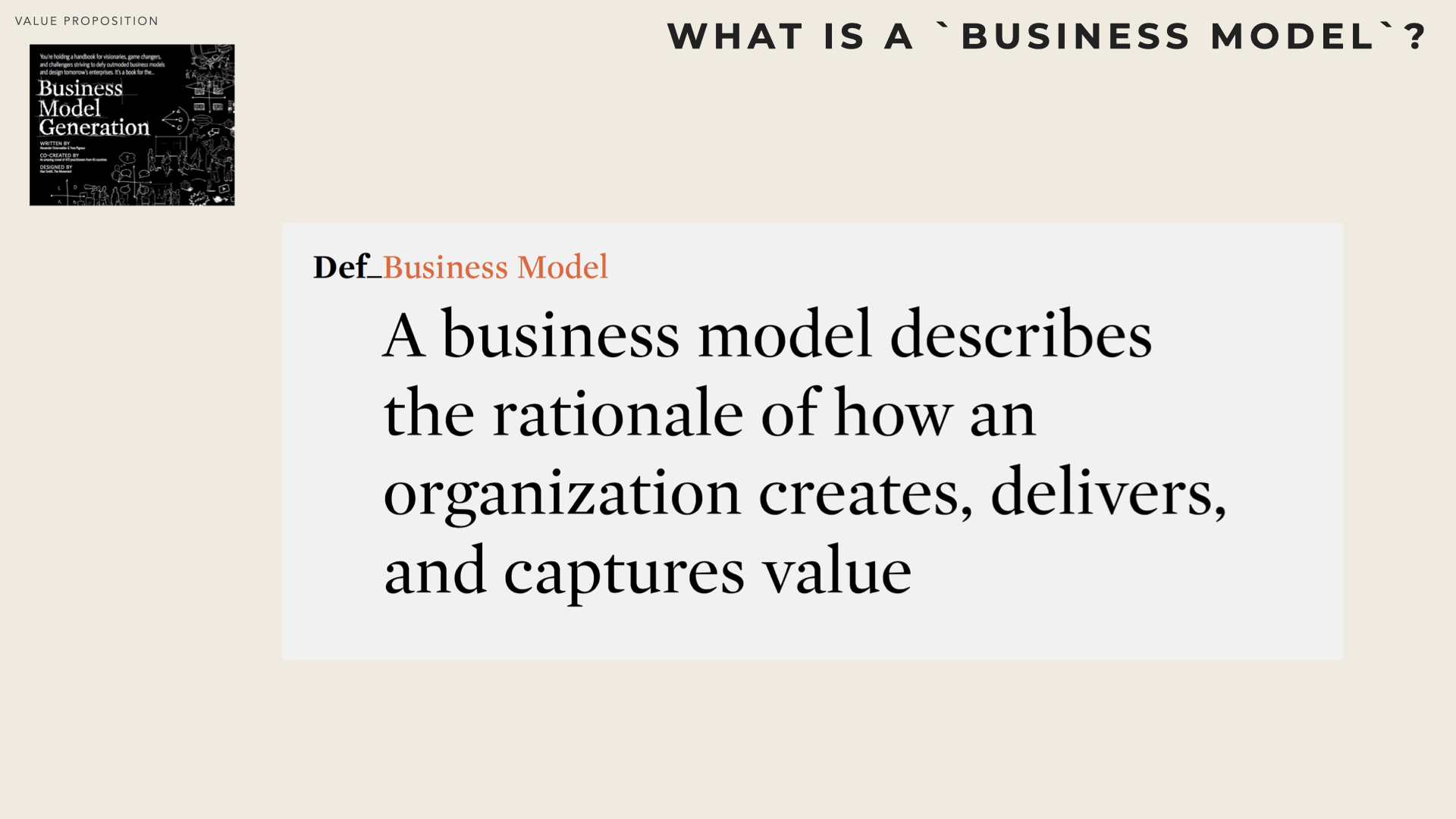
A Business Model is „the set of mechanisms by which a company can create value through the value proposition made to its customers, its value architecture and capture that value to turn it into profits” [Lehmann-Ortega].
The Odyssey Model
Odyssey, the simplest of the two models, emphasizes the three major aspects of any venture : WHAT is offered, HOW is it produced and can it be PROFITABLE?
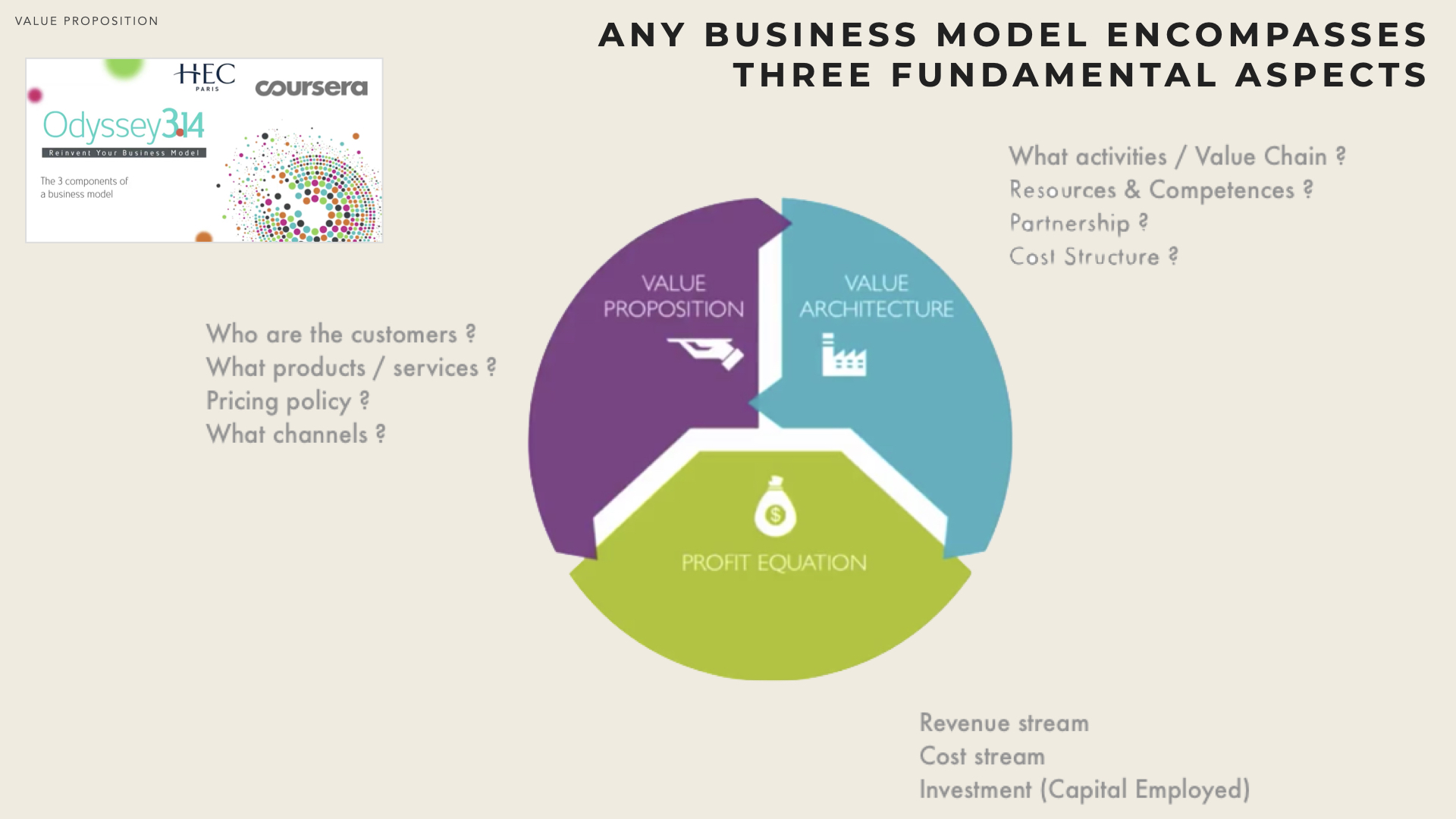
The model was designed by two professors at HEC and many students are likely to get exposed to it. The model is documented in a book and MOOCs are available as well. The model hinges upon three major components or pillars as the authors call them:
Value Proposition - the front-office aspects of any business: i) Who are the (possibly segmented) customers? ii) What products and services are offered? and iii) What pricing policy is associated to the various products and customers?
Value Architecture - how to deliver the value proposition: i) What are the required activities ? ii) What resources & competences are needed and are controlled by the firm ? iii) What is performed within the firm as opposed to outsourced to somebody else ?
Profit Equation - the quantitative summary of the whole: i) What are the revenues streams ? ii) What are the associated costs ? iii) What investments are required ?
The Odyssey model can be seen as a simplification of the business model canvas (see here-below).
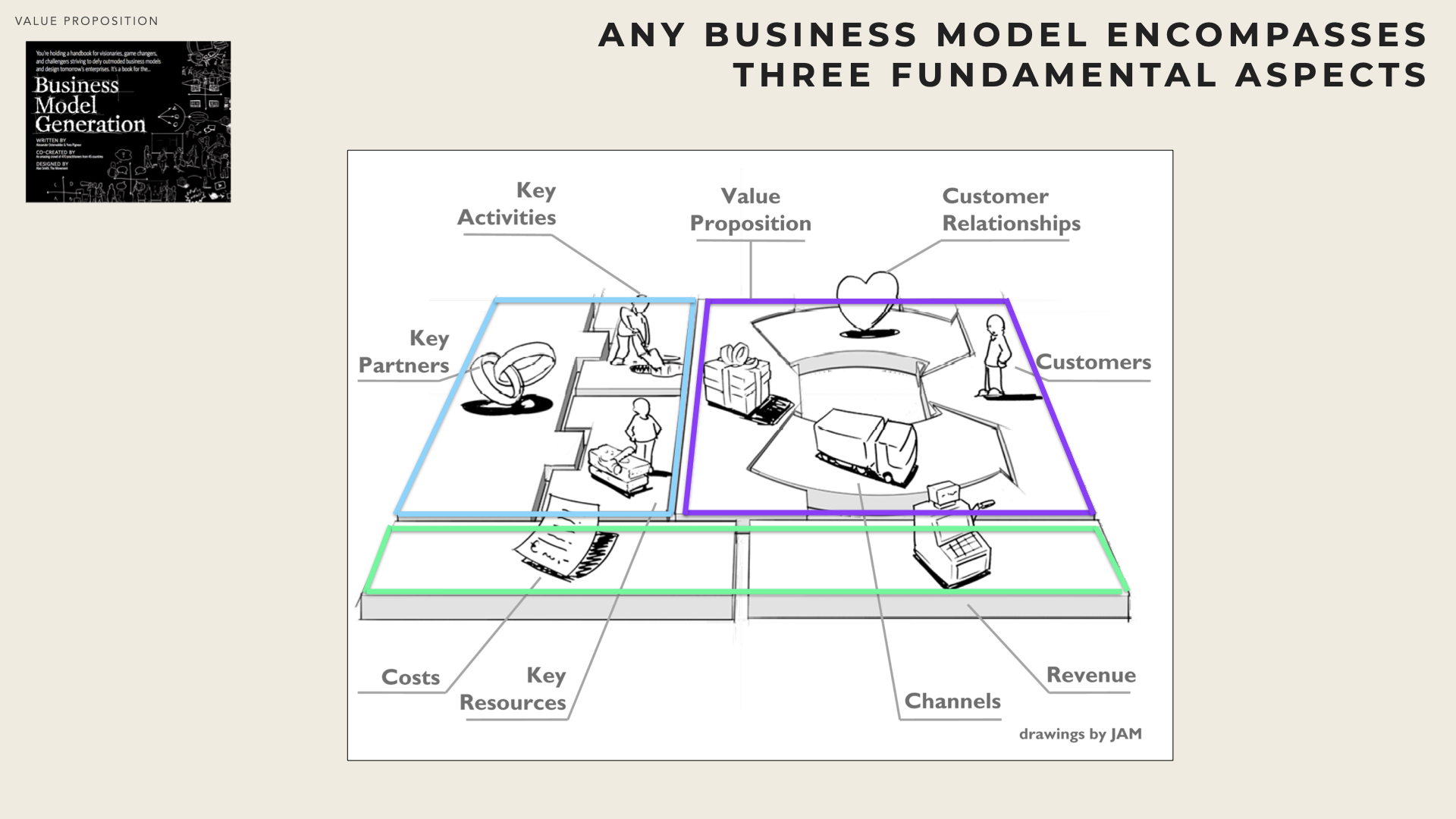
The Business Model Canvas
The business Model Canvas follows the same logic, but offers further refinements, by being more specific about the Value Proposition (including customer experience and interaction) and the Value architecture (including resources & competences and partnering).
Being very visual, the model (initially derived from A. Osterwalder’s academic work) is perfectly suited for group work for developing and documenting business models.
Compared to the Odyssey model, the BM Canvas is more detailed (i.e. top level components are further broken down into smaller constituents). However the very same rationale applies here as well.
Customers - two aspects are key with delineating targeted customers:
i) Customer Segments a company must identify which customers it tries to serve. Customers can be segmented into various subsets, according to their specific needs and attributes. Typical market attributes encompass the size (e.g. mass market vs niche market) and whether it corresponds to personal or professional consumption.
ii) some companies will serve mutually dependent customer segments. A credit card company will provide services to both credit card holders while simultaneously assisting merchants who accept those credit cards. The ability to recognise a multi-sided platform is pivotal to many business models Indeed, one type of customers only (e.g. advertisers) can generate revenues, while the most obvious value proposition is targeted at another category of customers.Value Proposition - The collection of products and services a company offers to meet the needs of its customers. The value proposition can encompass various elements such as newness, performance, ’one stop shopping’, customisation, ’getting the job done’, design, notoriety/brand/status, price, cost reduction, risk reduction, accessibility, and convenience/usability.
Channels - how a company reaches and engages its customer segments to deliver a Value Proposition. Channels are customer touch points that play a crucial role in the customer experience: raising awareness of the Value Proposition, evaluating the proposition relatively to alternatives, purchasing & ordering, receiving (delivery, shipment, …) the product or service and last but not least obtaining post-purchase support. A company can deliver its value proposition to its targeted customers through different channels: either through its own channels (store front, web site), partner channels (major distributors), or a combination of both. Effective channels will distribute a company’s value proposition in ways that are fast, efficient and cost effective.
Customer Relationship - this building block corresponds to the ways a firm wants to establish contact with a customer (mechanisms, timing, frequency, etc) for the purpose of customer acquisition, customer retention, up-selling and sales boost, etc. Customer loyalty is paramount to ensure the survival and success of any business. Companies must identify the type of relationship they want to create with their customer segments, which may include:
i) personal assistance during sales and/or after sales,
ii) dedicated personal assistance a sales representative is assigned to handle all the needs and questions of a special set of customers,
iii) self service the company provides the tools needed for the customers to serve themselves easily and effectively (typical of web-based business),
iv) automated service similar to self-service but more personalised as it has the ability to identify individual customers and his/her preferences. An example of this would be Amazon.com making book suggestions based on the characteristics of previous purchases,
v) communities allows for a direct interaction among different clients,
vi) co-creation the customer’s direct input is included in to the final company’s products/services (wikipedia is an example of co-created product).

Key Activities - underlines the most important activities (whether performed by the company or not) that are required to deliver the company’s value proposition.
Key Resources - (human, financial, physical and/or intellectual) necessary to carry out activities. Those activities for which the firm owns appropriate resources are usually performed in-house (‘make’ part). By contrast, the firm can choose to transfer some activities to external partners (‘buy’ part).
Partner Network - most companies rely on buyer-supplier relationships so they can focus on their core activity. Partnership, here also covers complementary business alliances (e.g. joint ventures, strategic alliances) between competitors or non-competitors. In case of ’multisided markets’, some Customers can easily get confused with Partners. For an external stakeholder to be a partner, the firm must transform the inputs it receives. For instance, content providers (movies, music albums, books) are more customers to i-tunes rather than suppliers/partners.

Profit - results from the difference between revenues and costs. The Business Model Canvas articulates the two sides of the equation and offer the opportunity to visually see how to increase revenues and/or reduce costs.
i) Cost Structure Characteristics it is essential to clearly identify Fixed Costs (including sunk costs) from variable costs.
ii) Revenue Streams the company must identify all the sources of its incomes and understand how each customer segment contributes to revenue generation.Even customers who are not responsible for any direct payment can contribute to generate revenues from other customer groups (e.g. network effect aka customer side economies of scale).
Relationships & channels
Osterwalder ( [Osterwalder10] ) stresses that there are different categories of customer groups, each leading to specific Customer Relationships and Distribution Channels:
Mass market - Business that focus on mass markets don’t seek to distinguish between customers. The Value Proposition as well as Distribution Channels and Customer Relationships target a large group of customers with very similar needs and expectations. There is very little customisation if any.
Niche market - Along side large groups of customers, there might exist smaller groups with very distinct needs. Tailoring the Value Proposition, Distribution Channels and Relationships to one of this smaller groups can allow very successful business models.
Segmented market - Some firms would rather deal with more than one customer group (either mass market or niche market). Serving several customer segments often imply establishing several distinct value propositions but also dedicated distribution channels and distinguished customer relationships.
Diversified market - Firm can also decide to address unrelated customer groups (serve very different needs). When Amazon.com launched AWS they star- ted a different business and faced diversified (possibly segmented) customer groups. Offering diversified Value Propositions usually requires implementing different Value Architectures.
Multi-sided market - Firms can serve several interdependent customer groups. Unlike segmented or diversified business models, a multi-sided business model relies on the two (or more) sides and requires the adhesion of the two sides to be successful.

Customer Value Creation
A mix of several attributes both quantitative (price, speed of service) or qualitative (novelty, design) contribute to customer value creation, including :
Newness - A Value Proposition can satisfy an entirely new set of needs, often that customers didn’t perceive previously. Such VP can rely on new technologies (e.g. smartphone), new social habits (e.g. shared economy) or personal aspiration (e.g. ethical funds).
Performance - The offering is comparable in essence to the pre-existing reference point but deliver more performance (e.g. computer disk space, processor power, display resolution). In a very mature market, performance only is unlikely to yield any significant market growth.
Customization - Sometimes called customer co-creation, allows a large range of customisation (e.g. colour, shape, etc…) while still benefiting from standardisation and economies of scale.
Getting the job done - Start from recognising customer hassle and help reduce the pain.
Design - a product may stand out because of superior design and for aesthetic reasons.
Brand / Status - the perceived value is not necessarily purely functional (derived from using the product). Sometimes owning / wearing the pro- duct can be a social signal that conceals value in itself
Risk reduction - a value proposition may encompass elements to reduce the risks incurred by a customer (e.g. guarantee, fixed-fees, service-level agreement)
Accessibility - innovations and/or new technologies can make product/service available to new customers. For the business model innovator this is a way to address previously untapped markets.
Classical Business models
This section briefly explores six very common and famous business model patterns ( [Osterwalder10] ) . Patterns must be seen as general, re-usable archetypes or architectural design ideas that can inspire new business models. This is a non-exhaustive list and other patterns could be considered as well.
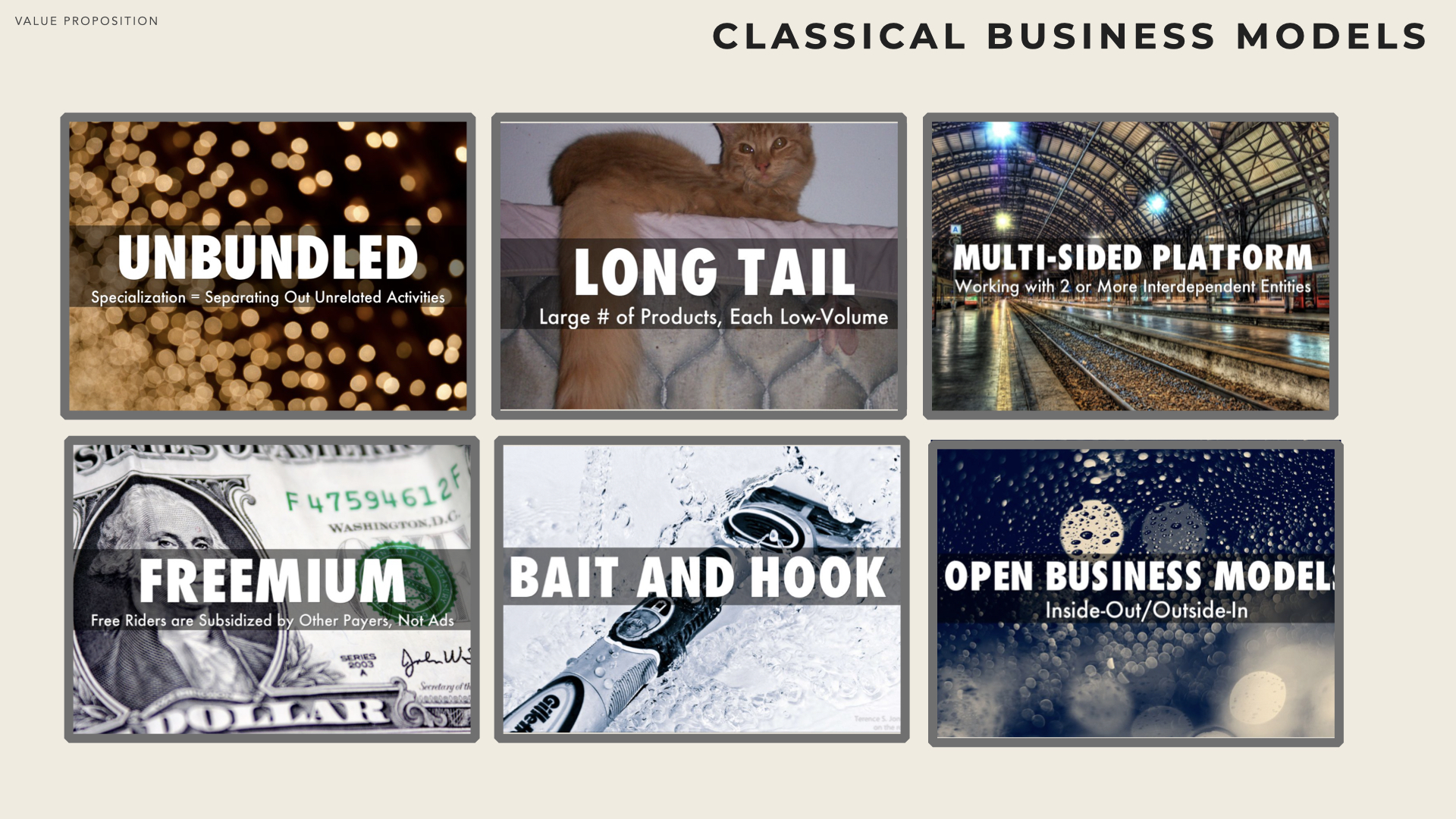
Most real life business cases are often a mix of several patterns. Understanding the patterns helps unveil the characteristics, building blocks and profit equation logic of real businesses.
It can also support business innovation in suggesting how an existing business model might evolve. It is key however to identify under which conditions a given business model pattern is effective. Otherwise patterns could be inappropriately applied.
Bundling / Unbundling
Unbundling is the process of breaking apart the various components of a product of service. Conversely bundling consists in grouping several items into a single Value Proposition.
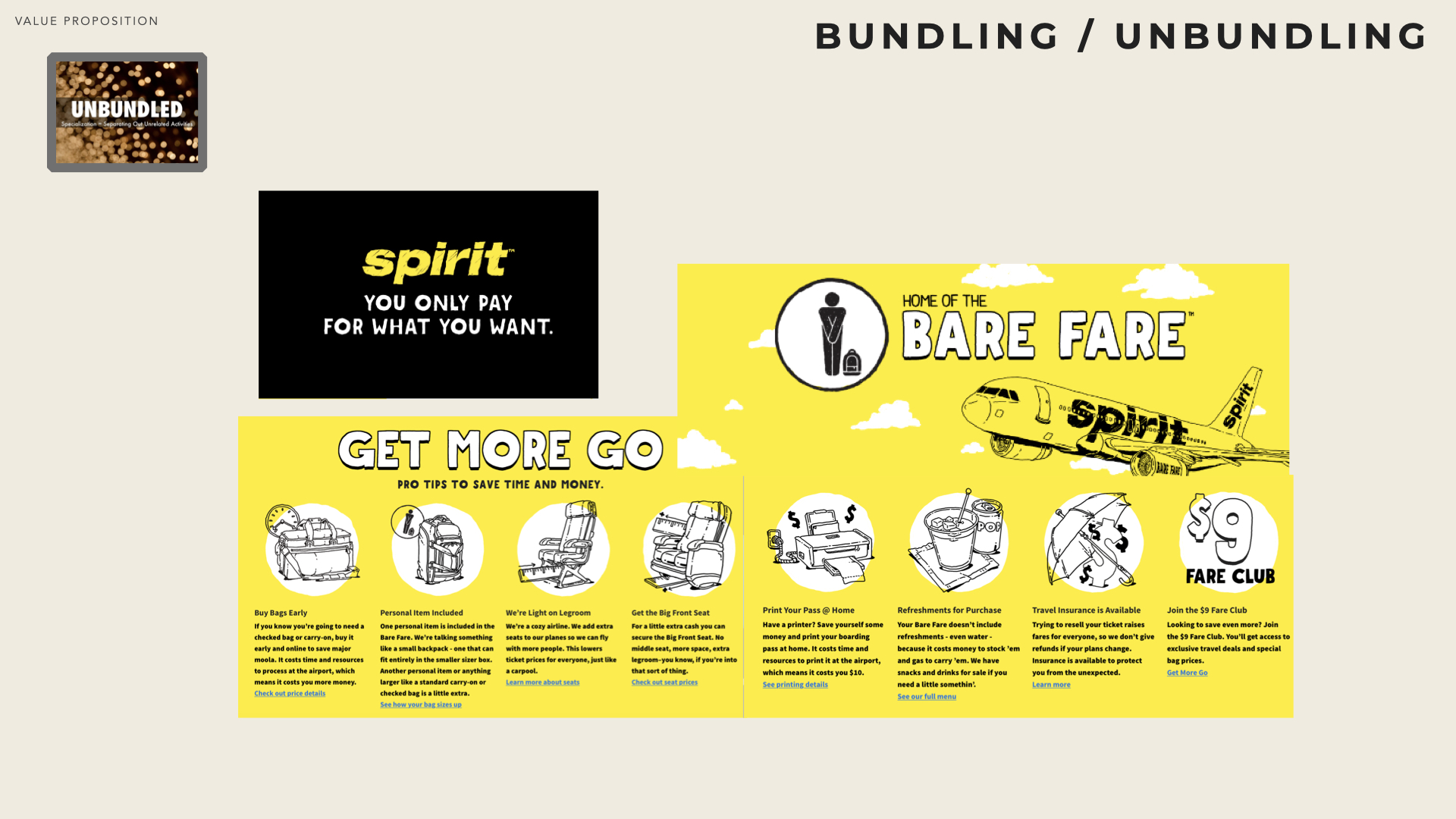
Unbundling allow for low-end differentiation: a lower price is offered as less features are included into the product/service. Low cost airlines are canonical examples of unbundling (additional services such as carry-on / check luggage, seat booking, extra leg room, printed ticket, on board refreshment, …, are billed on top of the fare).
More recently and in the context of the Internet, unbundling usually also suggests the dematerialisation and supply of contents at scale and cost unmatchable by former physical suppliers (e.g. MOOC vs in-class courses).
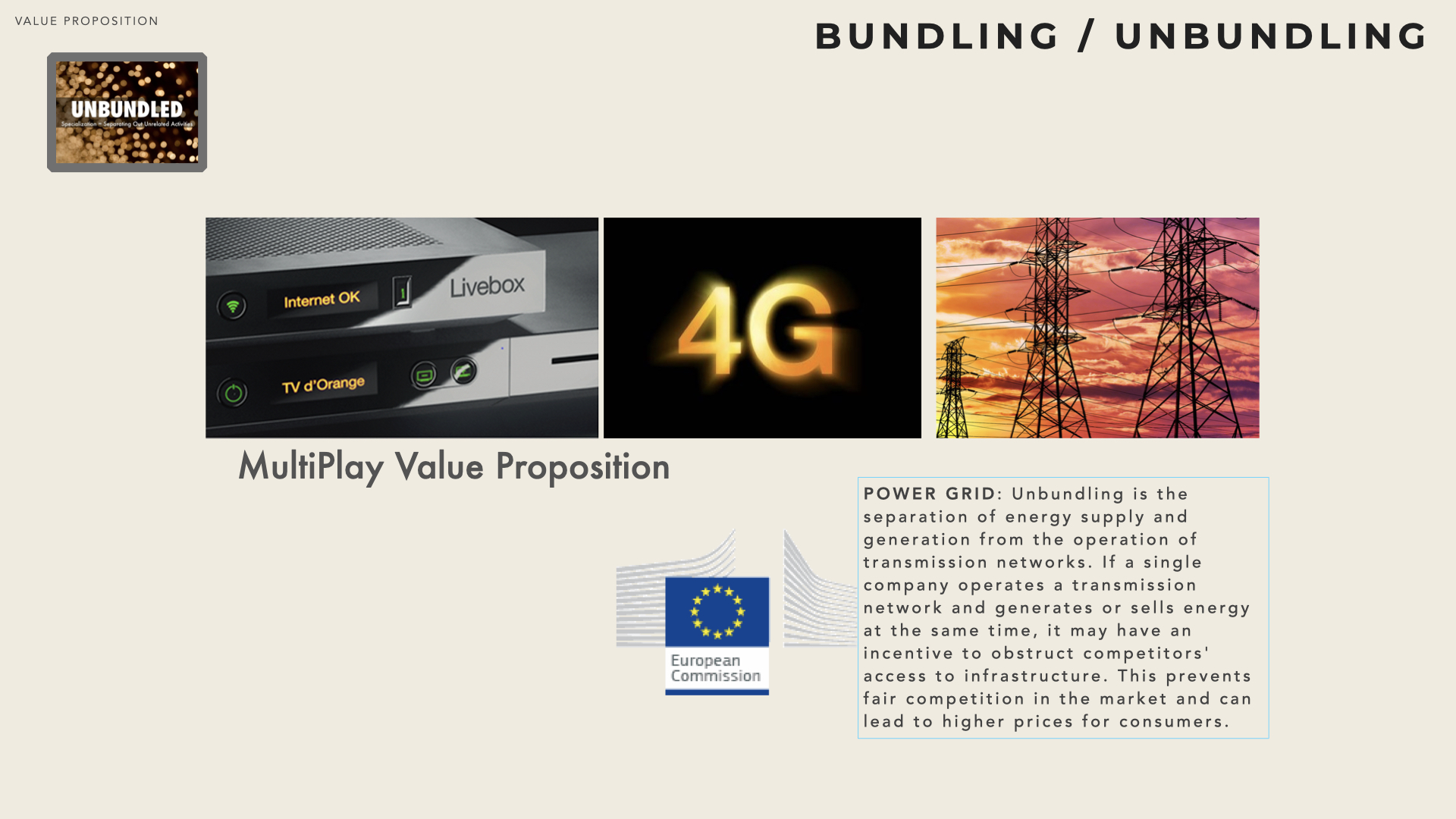
In the context of corporate strategy and mergers & acquisitions, unbundling can mean that a company with several lines of business is split and sold off in parts.

Competition Authorities (e.g. EU) are usually very keen to foster unbundling and limit market power & monopolistic situations. In Europe, the deregulation in the areas of Telecommunications, Railway Transport and Energy came with unbundling measures (e.g. separation of transport network and services to subscriber, separation of railway infrastructure and trains, separation of energy production and energy distribution).
Pay per X
Many business models still rely on cash-for-product: the revenue stream is associated with the transfer of ownership of a tangible product.
However there are many more ways to receive payment and innovative business models can be designed by offering different billing schemes.
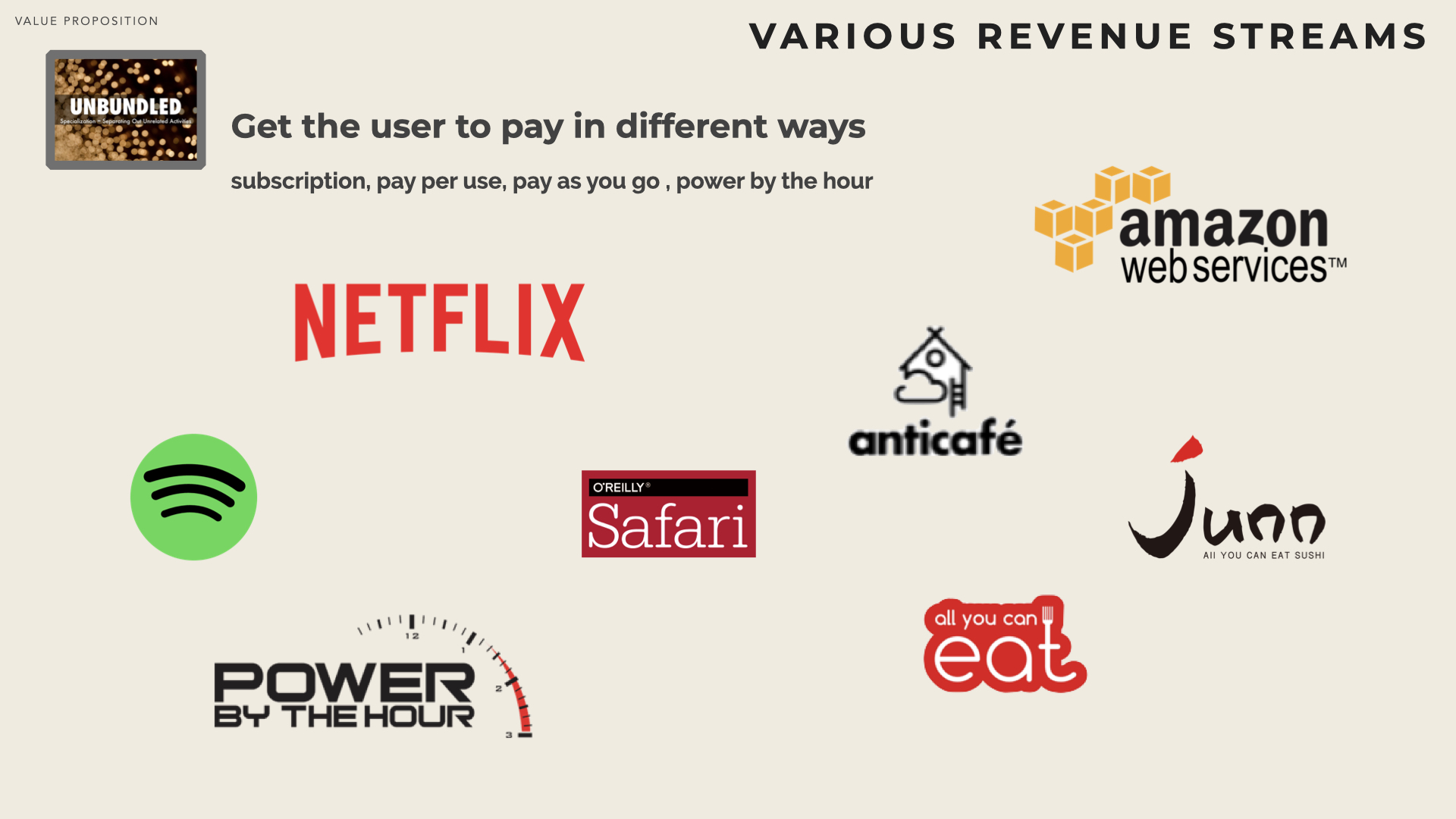
In pay-per-view or pay-per-use models the transfer of ownership of physical goods (e.g. purchasing a DVD) is replaced by a right-to-use service (e.g. watching a film). This scheme has been used by many brick-and-mortar businesses (e.g. Cinema, Hotel, Public Transport) and is becoming even more trendy with the Internet (car-pooling, cloud computing, etc…).
Subscription models are a form of pay-per-use services where nearly unlimited consumption is allowed for a certain period of time (e.g. Netflix, Safari on-line, Kindle). For instance, in the anticafé you don’t pay for what you drink or eat but for how long you stay.
With Power by the hour services, an OEM (car manufacturer, aircraft manufacturer, etc) takes responsibility for the maintenance, repair and overhaul for a flat-fee loan.
Long Tail
Although the phenomenon is well known from statisticians, the term long tail was first coined in business by Chris Anderson in 2004 in Wired Magazine and extended later in a book ( [Anderson06] ) .
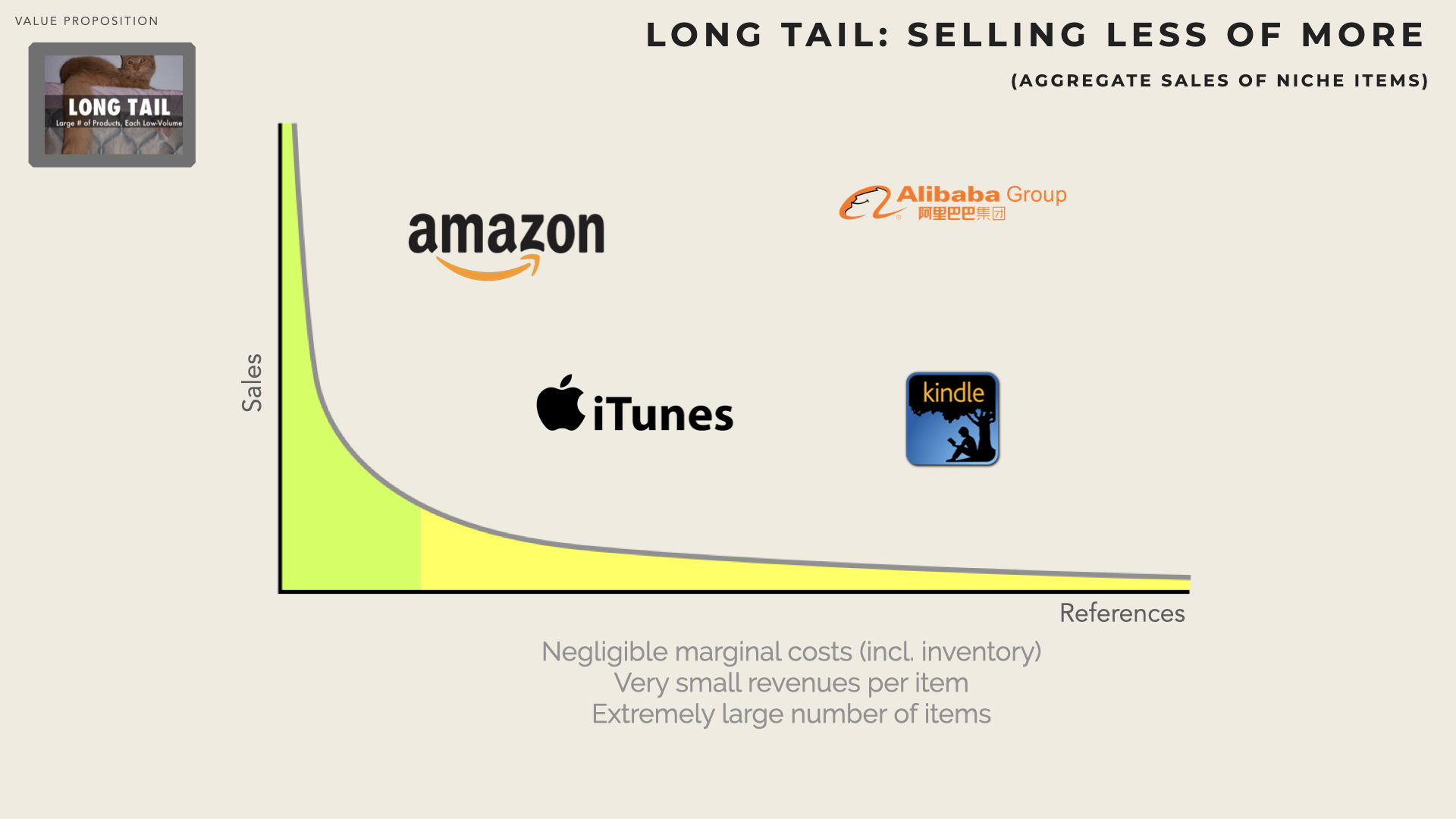
The main idea is that items in very low demand can still collectively make a significant market, provided that the costs of supply remain marginal (distribution, inventory, sourcing, …).
The model can barely be implemented by brick-and-mortar stores because the demand they are facing is not sufficient. By contrast, internet distribution allow players to address very large audience of potential customers which makes the model economically viable.
In the Wired Magazine Blog Josh Petersen, a former Microsoft and Amazon executive, described the long tail as “We sold more books today that didn’t sell at all yesterday than we sold today of all the books that did sell yesterday.”
Multi-sided
“Multi-sided Platforms bring together two or more distinct but interdependent groups of customers. Such platforms are of value to one group of customers only if the other groups of customers are also present. The platform creates value by facilitating interactions between the different groups. A multi-sided platform grows in value to the extent that it attracts more users, a phenomenon known as the Network Effect. Network effects and Positive feedback loops are economic terms that describe the snowballing benefits to front-runners in some markets.” ( [Ankaraju10] ) .
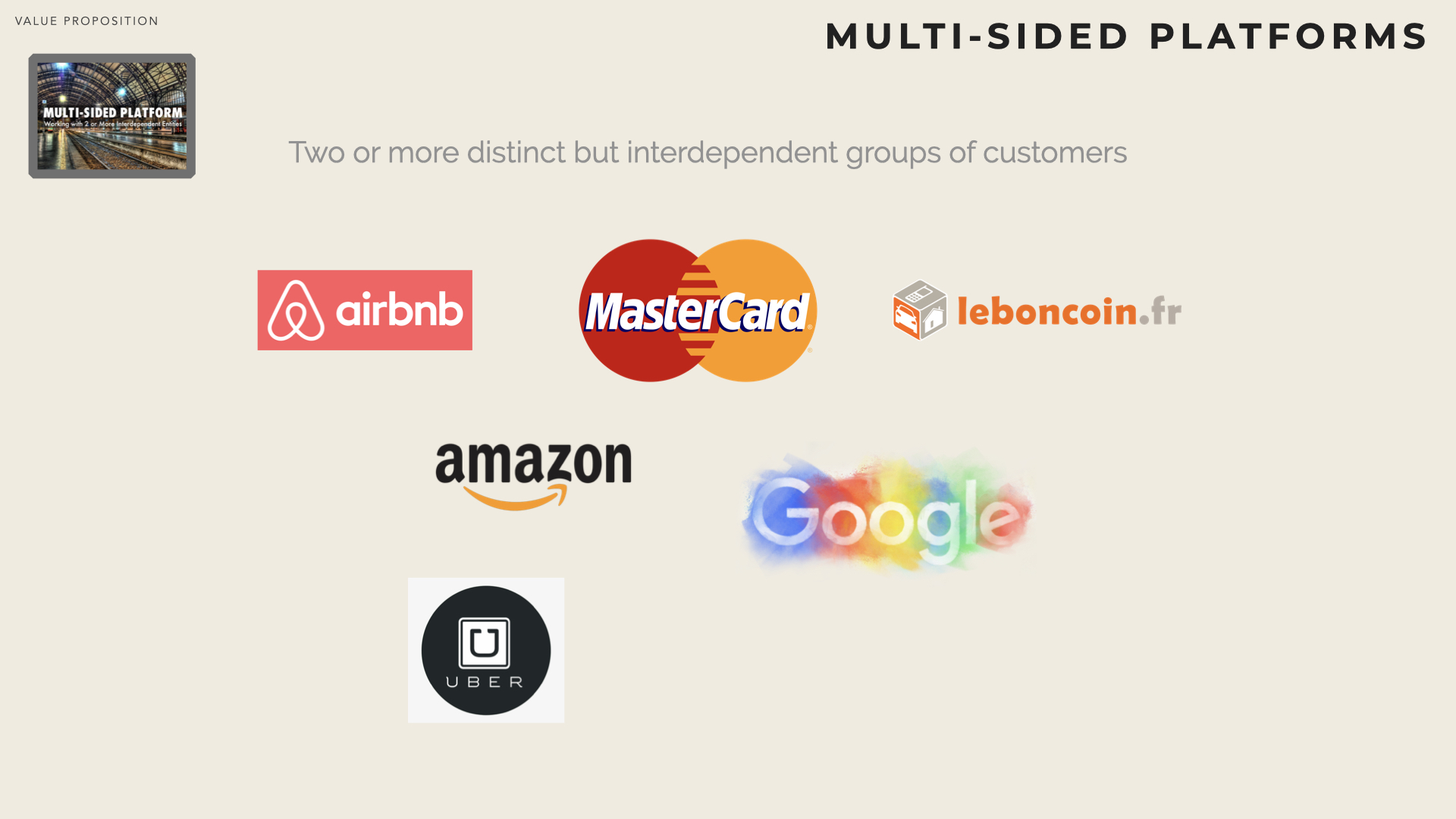
Multi-sided platforms (including two-sided) are not specific to Internet Businesses and have long existed before (e.g. credit card network, classified ad publications, etc…). The term platform refers here to the organisation that enables interactions between the distinct types of affiliated customers.
Nevertheless Internet Businesses are leveraging Multi-sided businesses like never before, as it allows for further segmentation/customisation.
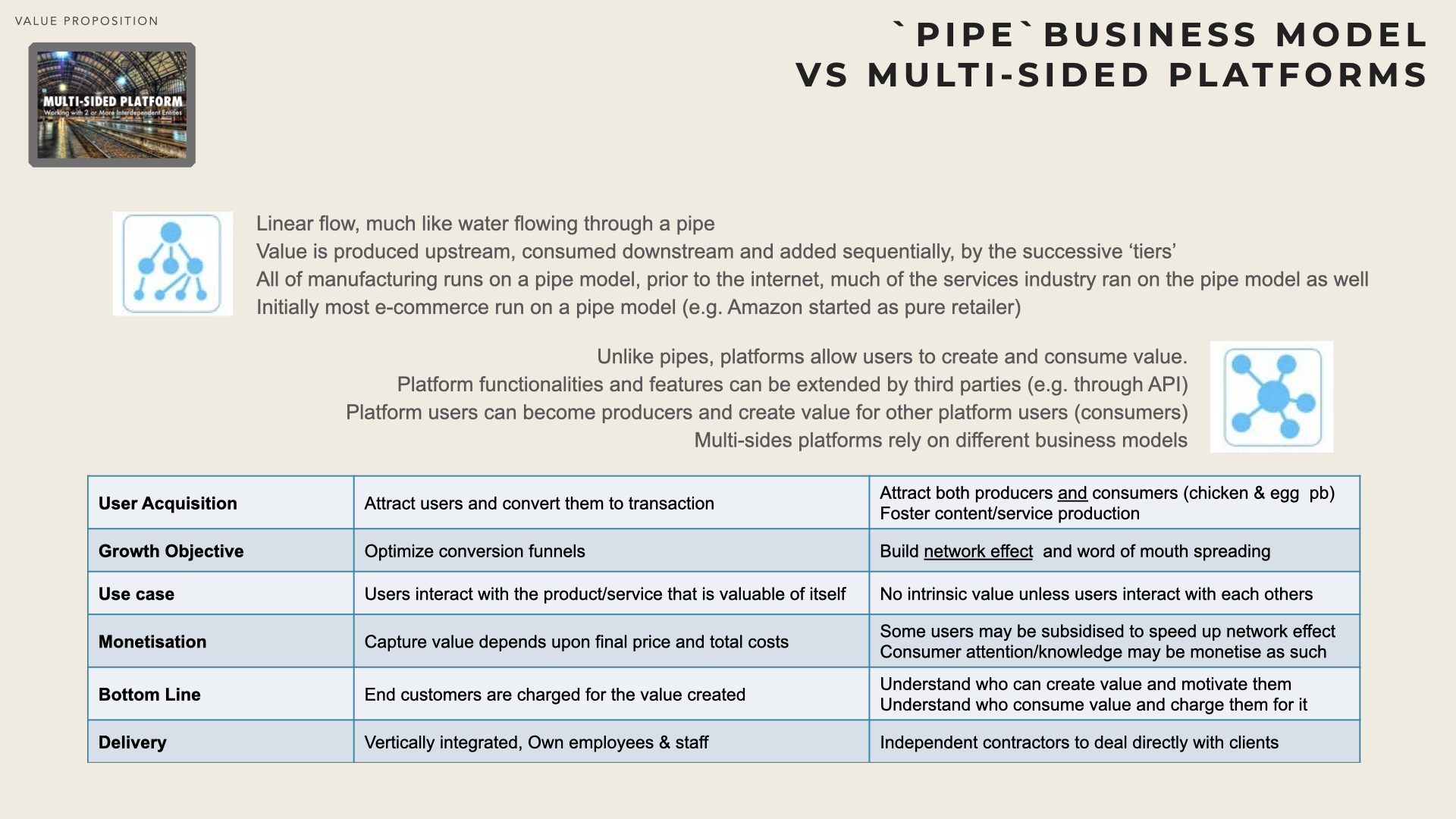
For multi-sided business models, it is paramount to identify the various types of customers and delineate their core interest/benefits. Then it is even more important to ensure that some of the total value created can be captured by the platform.
Freemium
Freemium is defined by wikipedia as ”a pricing strategy by which a product or service is provided free of charge”.
Freemium is extensively used by the software industry where pieces of soft- ware can be used free of charge (shareware) or the source code is made available for anyone to read, inspect or modify (open source). According to E. Seufert ( [Seufert14] ) one of the main reasons for deploying a Freemium business model is to quickly and efficiently acquire a large customer base through word of mouth, referral networks, social network, etc… and therefore enjoy significant demand economies of scale (network effect).
A freemium model is particularly suitable when the marginal cost of producing extra units is low. A freemium business model can be coupled with a multi-sided platform model, where revenues are captured from one type of affiliated customers only (e.g. advertisers). Likewise, a freemium business model can be associated with tiered services, where some extra features, capacity, services (e.g. support, training, configuration) are chargeable.

For instance, most cloud service providers – ranging from Infrastructure providers (IaaS), platform providers (PaaS) to software service providers (SaaS) – use freemium pattern in their business models.
Other examples include free-to-play games where games can be downloaded for free. Revenues are generated by in-game items that can be purchased by players to enhance game-play and/or aesthetics. For instance Thinkgaming.com estimates that in Nov 2016 the total revenue generated by Pokemon Go is nearly USD 5million, of which 10% from advertising and 90% from In-Application Purchases. In Jul 2018, Sensor Tower estimates total revenue for Pokemon Go has surpassed $1.8 billion
Bait & Hook
The Bait and Hook (aka Razor and Blade) business model was first introduced by Gillette: products (the razor in the case of Gillette) are sold at rather low price but require refills, consumables or additional products (the hook) that are sold at higher prices.
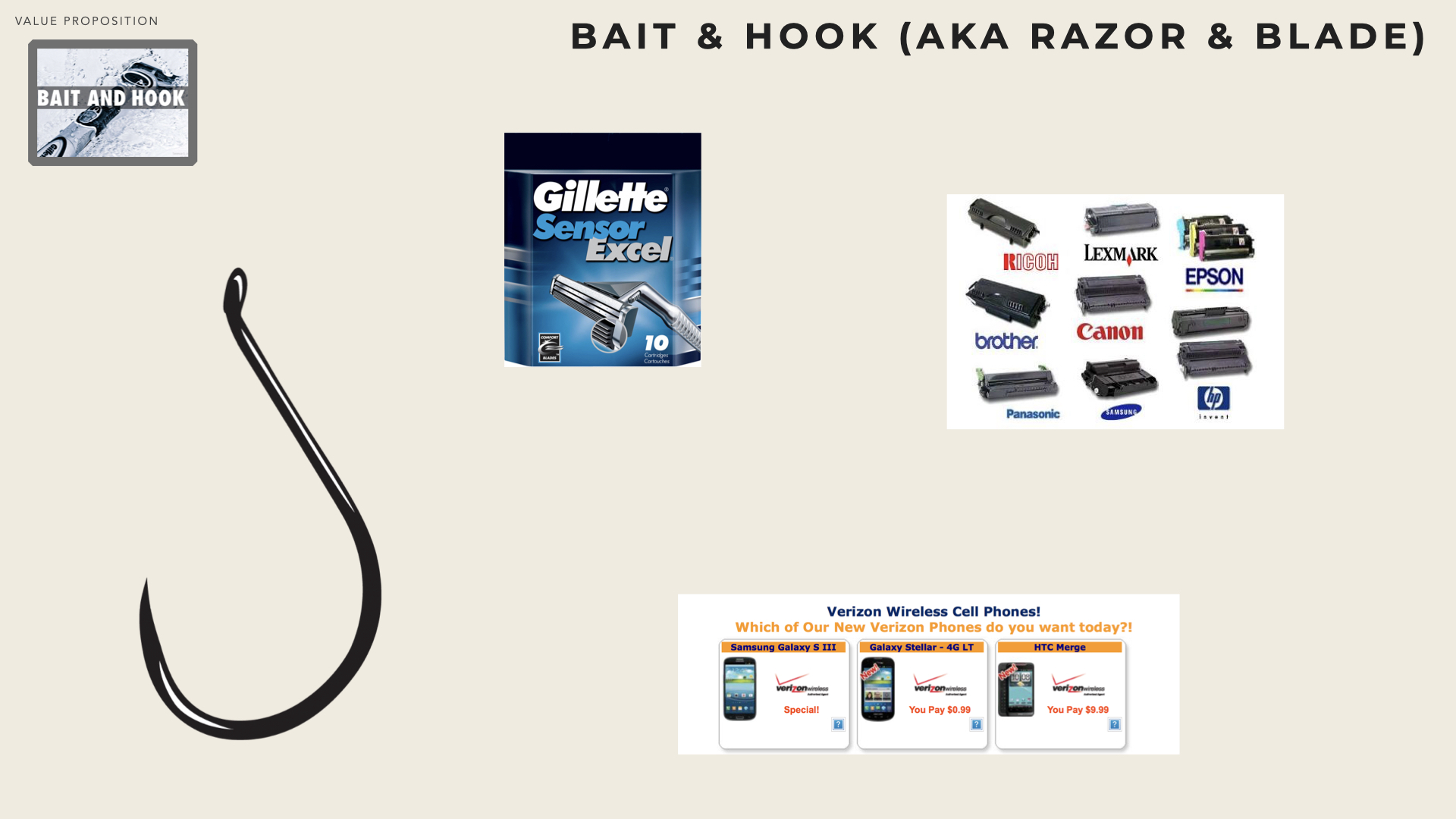
The model has been extensively used by companies who want to derive pro- fit from recurring purchases. For instance, Nespresso subsidises the purchase of Nespresso machines but sell Nespresso capsules. Telecom operators may provide cell phones for free or nearly for free in exchange for a data plan over several months.
Open innovation
Open innovation has been extensively studied by H. Chesbrough ( [Chesbrough03] [Chesbrough06] ) . In his own words
”Open innovation is a paradigm that assumes that firms can and should use external ideas as well as internal ideas, and internal and external paths to market, as the firms look to advance their technology ”.
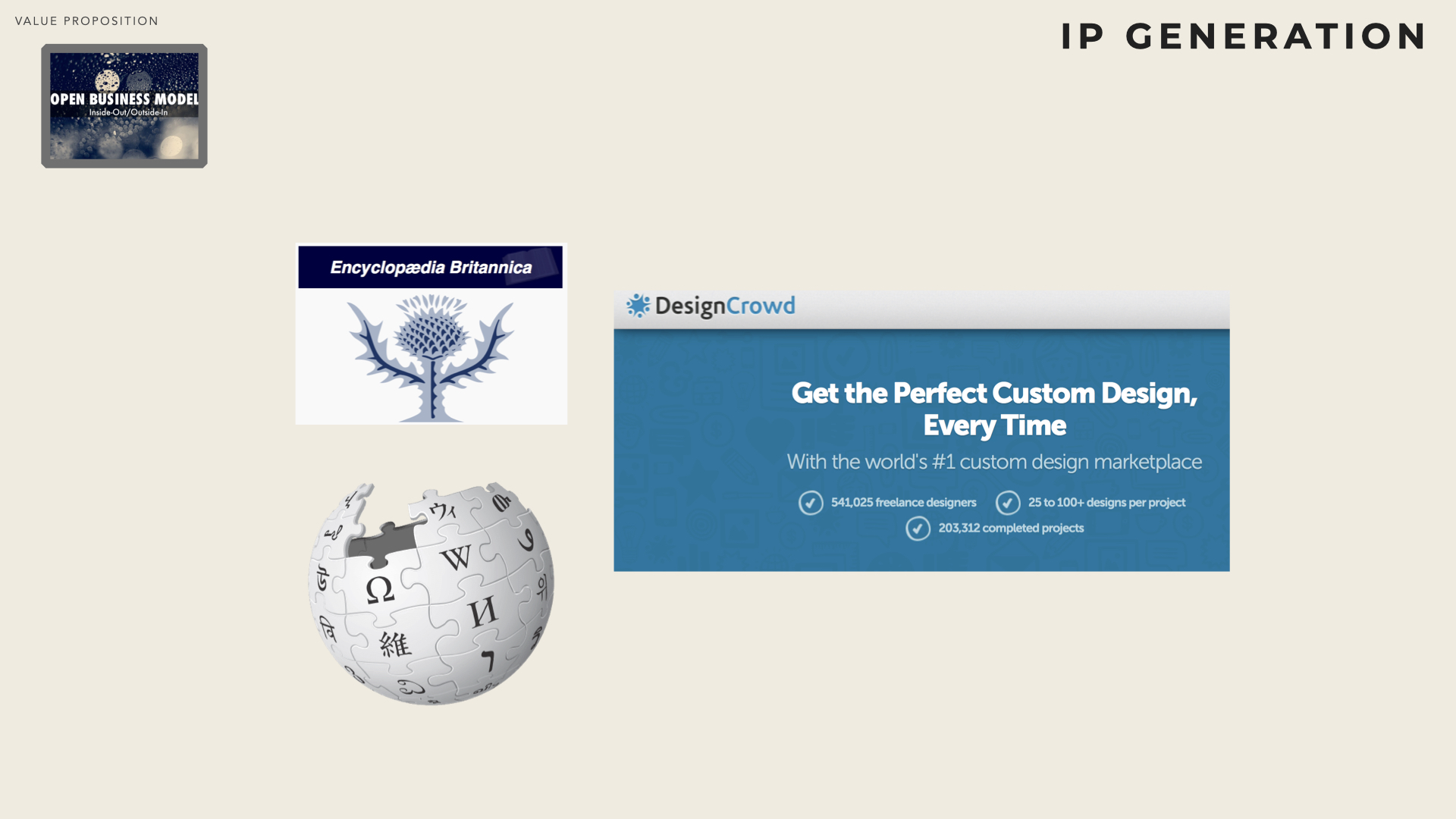
The main difference between closed and open innovation is that the later hinges upon widely distributed knowledge while the former rely on internal resources only. With the open innovation paradigm, a company can buy or operate inventions from third parties and likewise license or sell some of its own innovations. According to this model, knowledge and intellectual innovation is no longer concentrated in a few very large organisations. Smaller institutions or even individuals can find outlets for their work as companies look for ideas outside their boundaries.
With crown sourcing, (e.g. crown design) the model goes even beyond outsourcing innovation, in the sense that is creates a full eco-system where competing/collaborating organisations or people are bringing their insights and ideas.
Networks are often good for solving design and research problems because they can bring experts coming from different fields (including from outside of the firm’s industry). It is however important to define an adequate set of incentives to ensure that users from outside participate and that in-house experts don’t systematically get preference over experts from the crowd.
Business Model ontology
Considering the number of parameters that can influence a business, there are countless ways of clustering and depicting business models. However, the typology proposed ( [Malone06] ) is in many ways, illuminating as it first considers what asset rights are being sold by a firm, and then looks at what kind of assets are involved.
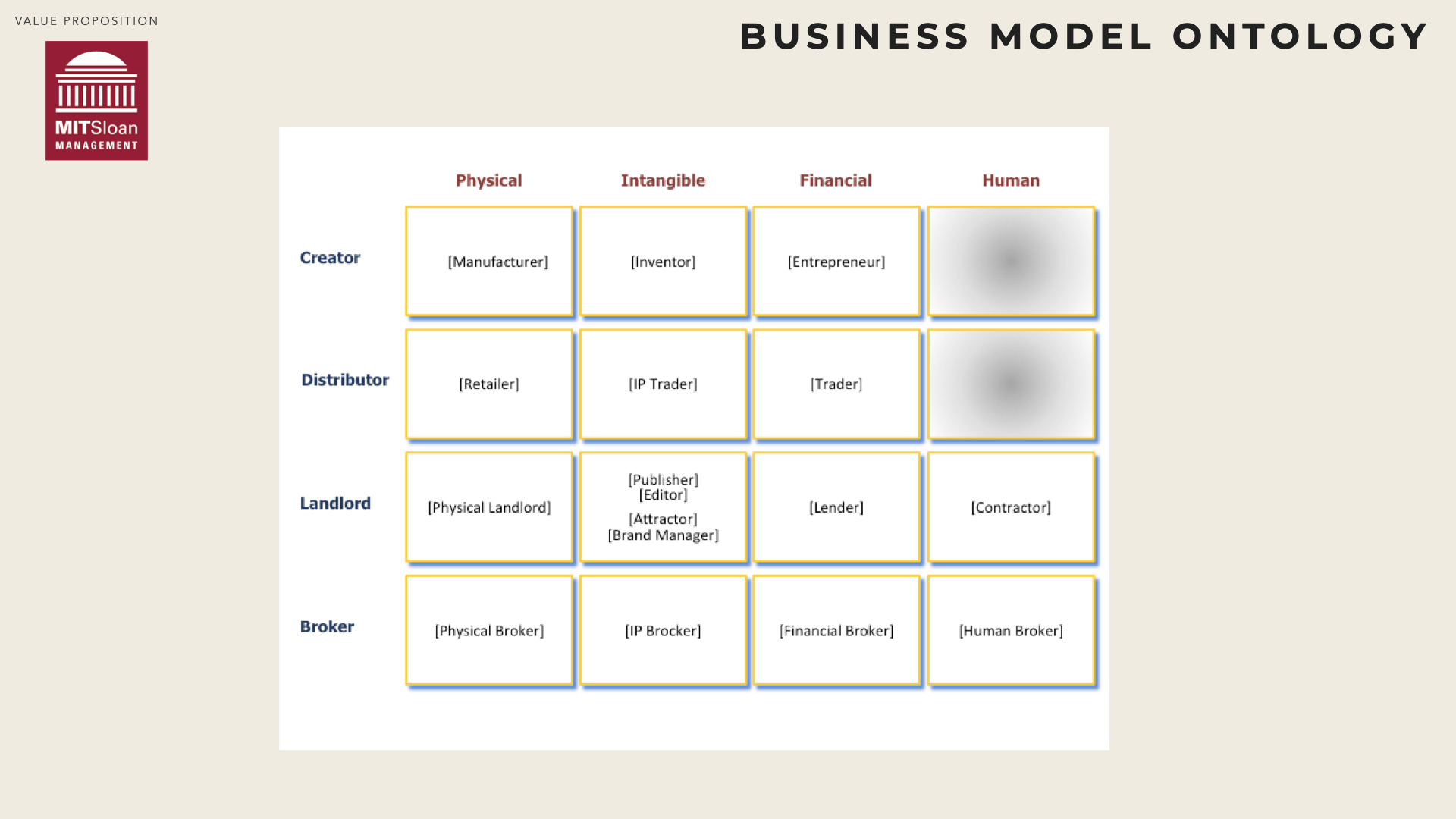
The following is a free adaptation of the framework original description.
Type of right sold The heart of any business is what it sells and offers to its customers. One of the most significant characteristic is the kind of legal right that is conferred to the buyer upon the completion of the transaction.
Right of ownership - Buyers acquire the continuing right to use an asset (the ownership title is transferred to the customer) in any way, including selling, destroying, or disposing of it. It is usually useful to distinguish between firms that build what they sell (e.g. manufacturers) from those that sell what other firms have made (e.g. retailers).
Right to use - Customers buy the right to use assets (e.g. rented car, hotel room, phone subscription, pay-tv) in a certain way for a given period of time, while the ownerships of the asset is not transferred.
Right to Match - is the right to be matched with potential buyers or sellers of something. For instance a real estate broker first secures the right to buy, sell or lease a property on behalf of the principal and then can sell this right to a counter-party.
Categories of Firms Based on the type of right criterion, there are mainly four categories of firms. Obviously a firm may offer various value propositions based on different business models. In the remaining we assume a single, unbundled offer.
Creator - designs a product, buys raw materials and inputs from upstream suppliers, then transforms or assembles – a creator can outsource the manufacturing of its product – them to create a ’product’ sold to buyers.
Distributor - buys a product and resells essentially the same product to somebody else. The distributor may offer additional services like repackaging or transporting the product.
Landlord - sells the right to use (i.e. to make temporally use of an asset) but not to own.
Broker - facilitates sales by matching potential buyers and sellers. Unlike a distributor, a broker doesn’t take ownership of the product being sold. A Broker can receive a fee from the buyer, the seller or both.
Types of assets A business model is also characterized by the type of assets for which rights are being sold.
Physical any durable items (building, computer, and machine tools) as well as nondurable items (food, clothing, paper),
Intangible legally protected intellectual property (patents, copyrights, trademarks, etc..) as well as other intangible assets like knowledge, goodwill, brand,
Financial cash and other assets like stocks, bonds, insurance policies that give their owners rights to potential future cash flows,
Human people time and effort
Combination In theory, each of the types of right can be associated with each of the types of assets which yields sixteen different business models. The list of business models and associated definitions are verbatim from [Malone et al., 2006].
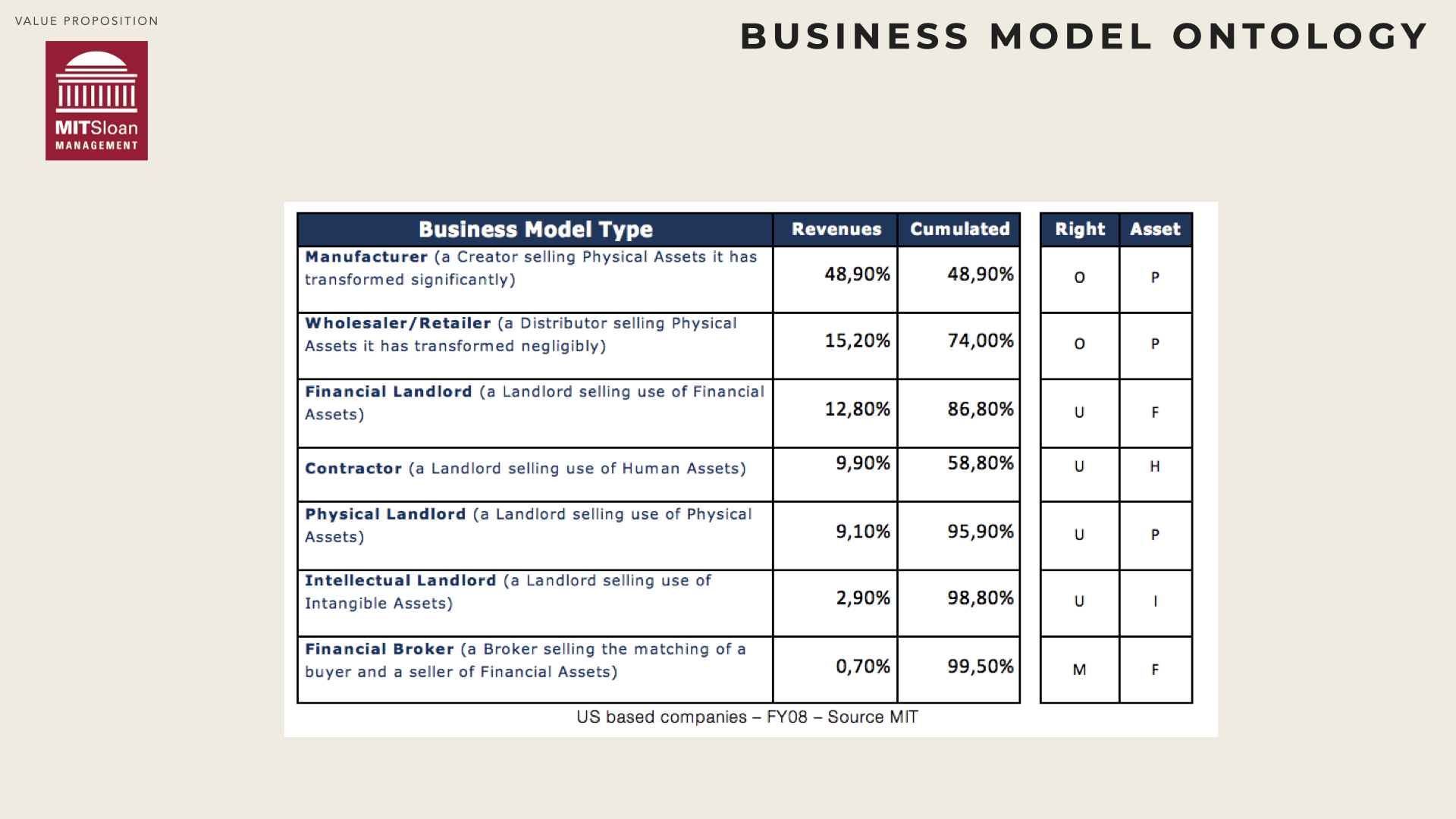
Manufacturer creates and sells physical assets. Manufacturer is the predominant type of Creator. Examples: Airbus, General Motors.
Inventor creates and then sells intangible assets such as patents and copyrights. Firms using this business model exclusively are relatively rare, but some technology firms generate part of their revenues this way. Firms that license the use of their intangible assets while still retaining ownership are not classified as Inventors; they are Intellectual Landlords (see below).
Entrepreneur creates and sells financial assets often creating and selling firms. We do not include in this business model entrepreneurs who never sell the firms they create.
Human Creator creates and sells human assets. Malone stressed that since selling human –whether they were created naturally or artificially or obtained by capture– is illegal and morally repugnant in most places today, this business model is included here for logical completeness and as a historical footnote about a form of business model that was more common in the past. However, the new development in AI and robotics may relaunch this business model by creating and selling robots.
Wholesaler/Retailer buys and sells physical assets. This is the most common type of Distributor. Examples : Wal*Mart, Amazon.
Intellectual Property Trader buys and sells intangible assets. This business model includes firms that buy and sell intellectual property such as copyrights, patents, domain names, etc.
Financial Trader buys and sells financial assets without significantly transforming (or designing) them. Banks, investment firms, and other fi- nancial institutions that invest for their own account are included in this business model.
Human Distributor buys and sells human assets. Like Human Creators, this business model is illegal and rare in most places and is included here only for logical completeness.
Physical Landlord sells the right to use a physical asset. The asset may, for example, be a location (such as an amusement park) or equipment (such as construction equipment). Depending on the kind of asset, the payments by customers may be called ’rent’, ’lease’, ’admission’, or other similar terms. This business model is common in industries like real estate rental and leasing, accommodation, airlines and recreation.
Intellectual Landlord licenses or otherwise gets paid for limited use of intangible assets. There are three major subtypes of Intellectual Landlord i) a publisher provides limited use of information assets such as software, newspapers, or databases in return for a purchase price or other fee (often called a subscription or license fee), ii) a Brand Manager gets paid for the use of a trademark, know-how, or other elements of a brand. This includes franchise fees for businesses such as restaurant or hotel chains and iii) an Attractor attracts people ?s attention using, for example, television programs or web content and then ?sells ? that attention (an intangible as- set) to advertisers. The Attractor may devote significant effort to creating or distributing the assets that attract attention, but the source of revenue is from the advertisers who pay to deliver a message to the audience that is attracted. This business model is common in radio and television broad- casting, some forms of publishing, and some Internet-based businesses. Example : New York Times, Google.
Financial Landlord lets others use cash (or other financial assets) under certain (often time-limited) conditions. There are two major subtypes i) Lenders provide cash that their customers can use for a limited time in return for a fee (usually called ’interest’) and ii) Insurers provide their customers financial reserves that the customers can use only if they experience losses. The fee for this service is usually called a ’premium’.
Contractor sells a service provided primarily by people, such as consulting, construction, education, personal care, package delivery, live entertainment or healthcare. Payment is fee for service, often (but not always) based on the amount of time the service requires. In most cases, Contractors also require physical assets (such as tools and workspace), and Physical Landlords also provide human services (such as cleaning hotel rooms and staffing amusement parts) associated with their physical assets. In cases where substantial (more than 50% in value) amounts of both human and physical assets are used to provide a service, we classify a firm’s business model (as Contractor or Physical Landlord) on the basis of which kind of asset is ’essential’ to the nature of the service being provided.
Financial broker matches buyers and sellers of financial assets. This includes insurance Brokers and stock Brokerage functions in many large financial firms.
Physical broker matches buyers and sellers of physical assets. Examples: eBay, Century 21.
Intellectual property (IP) broker matches buyers and sellers of intangible assets.
Human Resources (HR) broker matches buyers and sellers of human services. Examples: interim agencies